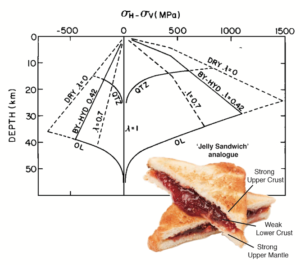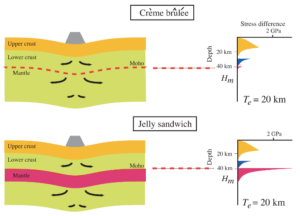
In 1980 Brace and Kohlstedt published a short paper that constrains the strength of continental lithosphere by extrapolating laboratory measurements of rock strength to geological conditions. Their approach follows earlier work by Goetze and Evans (1979) and relies on two key considerations. First, the brittle strength is given by the frictional strength of rocks following Byerlee’s law (Byerlee, 1978). With this assumption, one can calculate the pressure-dependent increase of the lithospheric stress with depth, and account for the strength-reducing effect of pore fluid pressure (see TS-must-read blogpost of August 13, 2020; Hubbert & Rubey, 1959). Second, the stress in the lithosphere is ultimately limited by thermally activated creep mechanisms, where the ductile strength of the rock decreases with increasing temperature and depth. To account for the ductile rheology of the crustal and mantle parts of the lithosphere, Brace and Kohlstedt adopted quartz and olivine flow laws, respectively. The rheology of feldspathic rocks, which is nowadays commonly considered to account for deformation in the lower continental crust, was not yet well constrained at this time.

Figure 1: Difference between maximum horizontal stress and vertical stress (approximation to lithospheric strength) as a function of depth, with λ indicating pore pressure level (Brace and Kohlstedt, 1980). QTZ = quartz and OL = olivine. Jelly sandwich (see text) inset from depositphotos.com (ID: 18002439)
Based on the above considerations, Brace and Kohlstedt calculated failure envelopes for continental lithosphere and different pore fluid pressure conditions; dry, hydrostatic, and moderately overpressured (Figure 1). Although the absolute stresses differ with the pore fluid pressure conditions, all failure envelopes share one fundamental characteristic: a strong upper continental crust and uppermost mantle and a relatively weak lower continental crust in-between. This strength distribution founded the popular “jelly sandwich” description of continental lithosphere and has greatly influenced conceptual and numerical models of continental deformation (e.g., Burov & Diament, 1995). It took about two decades, until the jelly sandwich became challenged as the general model for lithospheric strength (Jackson, 2002; Maggi et al., 2000). This triggered a healthy debate about the properties of continental lithosphere (e.g., Burov & Watts, 2006; Lamb, 2002; Figure 2). We come back to this fundamental debate when discussing the review paper of Bürgmann and Dresen (2008) later in the TS-Must Read series (see link).

Figure 2: Schematic diagram illustrating the main first-order models for lithospheric strength (Burov & Watts, 2006), with the weak-mantle “Creme brulee” model above, and the strong-mantle “Jelly sandwich” model proposed by Brace and Kohlstedt (1980) below.
In the discussion on the Reddit forum there are contributions by Gino de Gelder and Armin Dielforder. Gino points out that the paper makes an impressive jump across scales from the laboratory to the lithosphere, and sees the paper as a good example of coming up with a new model without requiring new data. Armin highlights how the paper triggered discussions within a lot of subsequent papers on continental rheology, usually with food analogues. He also points out an element that is not really touched within the Brace & Kohlstedt (1980) paper: the difference in lithospheric strength between fault zones and the continental interiors. Whereas Brace & Kohlstedt would argue for different hydrostatic pressures as a key reason, other processes like phyllosilicate friction might be (more) important? Feel free to add your thoughts on the forum.
Written by Armin Dielforder, Gino de Gelder, Utsav Mannu and the TS-must read group
References
Brace, W.F., Kohlstedt, D.L., 1980. Limits on lithospheric stress imposed by laboratory experiments. Journal of Geophysical Research, 85, 6248–6252.https://doi.org/10.1029/JB085iB11p06248
Burov, E.B., Diament, M., 1995. The effective elastic thickness (Te) of continental lithosphere: What does it really mean? Journal of Geophysical Research, 100, 3905–3928. https://doi.org/10.1029/94JB02770
Burov, E.B., Watts, A.B., 2006. the long-term strength of continental lithosphere: “jelly sandwich” or “crème brûlée”? GSA Today, 16, 4–10. https://doi.org/10.1130/1052-5173(2006)016<4:TLTSOc>2.0.CO;2
Jackson, J., 2002. Strength of the continental lithosphere: Time to abandon the jelly sandwich? GSA Today, 12, 4–10. https://doi.org/10.1130/1052-5173(2002)012<0004:SOTCLT>2.0.CO;2
Lamb, S., 2002. Is it all in the crust? Nature, 420, 130–131. https://doi.org/10.1038/420130a
Maggi, A., Jackson, J.A., McKenzie, D., Priestley, K., 2000. Earthquake focal depths, effective elastic thickness, and the strength of the continental lithosphere. Geology, 28, 495–498. https://doi.org/10.1130/0091-7613(2000)28<495:EFDEET>2.0.CO;2
